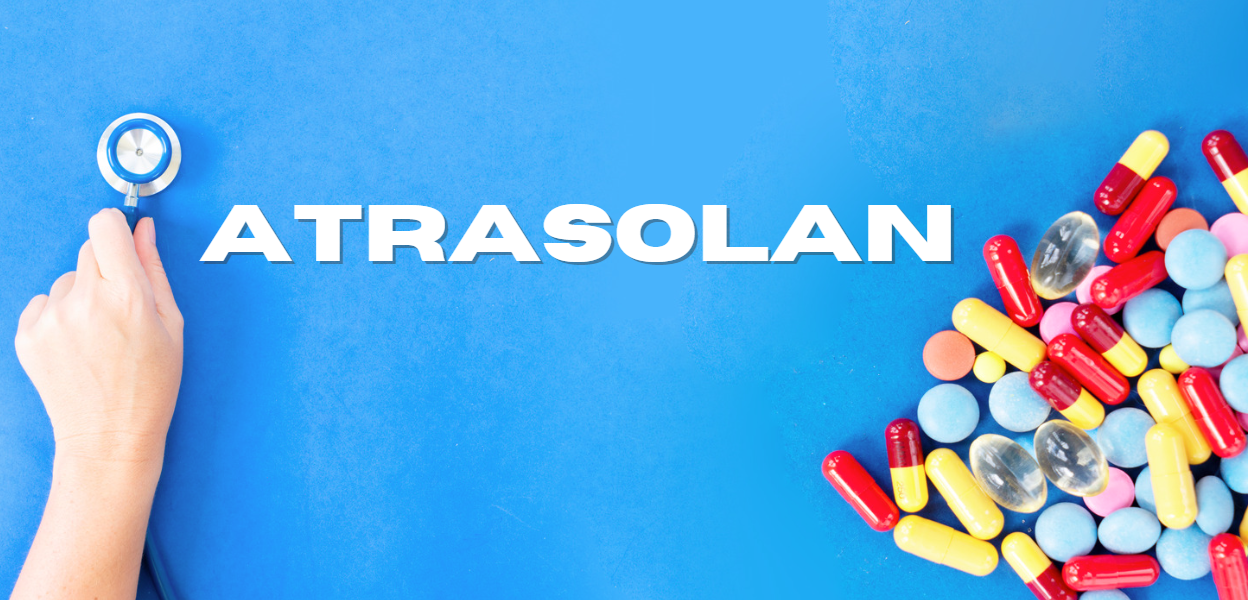Contents
- 1 Introduction to Atrasolan
- 2 What is Atrasolan?
- 3 The Chemical Structure of Atrasolan
- 4 How Does Atrasolan Work?
- 5 Potential Applications of Atrasolan
- 6 Atrasolan in Clinical Trials
- 7 Potential Side Effects of Atrasolan
- 8 Atrasolan: Benefits vs. Risks
- 9 Atrasolan in the Pharmaceutical Market
- 10 The Future of Atrasolan
- 11 Atrasolan: Ethical Considerations
- 12 FAQs About Atrasolan
- 13 Conclusion
Introduction to Atrasolan
Atrasolan is a term that has been generating considerable interest in various fields, particularly in the medical, pharmaceutical, and scientific communities. Despite the increasing attention, there remains a lack of detailed and accessible information available to the general public. This article aims to fill that gap by providing a comprehensive overview of Atrasolan, its applications, benefits, potential risks, and its significance in various industries.
What is Atrasolan?
Atrasolan is a compound that has been the focus of extensive research due to its potential applications in treating various health conditions. Though still under study, it has shown promise in fields such as neurology, psychiatry, and pharmacology. Atrasolan is often categorized as a psychoactive substance, which means it affects brain function, resulting in changes in perception, mood, consciousness, cognition, or behavior. However, its full spectrum of effects and potential uses are still being explored.
The Chemical Structure of Atrasolan
To understand Atrasolan, it’s essential to grasp its chemical makeup. Atrasolan is a synthetic compound, meaning it is man-made rather than naturally occurring. Its chemical structure is designed to interact with specific receptors in the brain and other parts of the body. The exact formulation of Atrasolan is complex, involving multiple bonds and atoms that contribute to its unique properties. While the detailed chemical structure might be too technical for the average reader, it’s important to know that its design is what makes Atrasolan both effective and a subject of ongoing research.
How Does Atrasolan Work?
Atrasolan works by interacting with neurotransmitters in the brain. Neurotransmitters are chemicals that transmit signals across a synapse from one neuron (nerve cell) to another. Atrasolan influences these neurotransmitters, particularly those related to mood regulation, anxiety, and cognitive functions. By modulating these neurotransmitters, Atrasolan can potentially alleviate symptoms associated with various mental health disorders.
Interaction with Serotonin Receptors
One of the key ways Atrasolan exerts its effects is through its interaction with serotonin receptors in the brain. Serotonin is a neurotransmitter that plays a crucial role in regulating mood, anxiety, and happiness. Atrasolan’s ability to modulate serotonin levels is one reason it is being studied for its potential antidepressant and anxiolytic (anxiety-reducing) effects.
Dopamine Modulation
In addition to serotonin, Atrasolan also impacts dopamine levels. Dopamine is another neurotransmitter that is closely linked to the brain’s reward system and is often associated with feelings of pleasure and motivation. By affecting dopamine levels, Atrasolan may influence behaviors and conditions related to addiction, motivation, and overall mental well-being.
Potential Applications of Atrasolan
The potential applications of Atrasolan are vast, particularly in the fields of mental health and neurology. Below are some of the most promising areas where Atrasolan could have a significant impact:
1. Treatment of Depression
Depression is one of the most common mental health disorders globally, affecting millions of people. Traditional antidepressants often come with a range of side effects and do not work for everyone. Atrasolan, with its unique mechanism of action, has the potential to offer a new approach to treating depression, particularly in cases where other treatments have failed.
2. Anxiety Disorders
Anxiety disorders, including generalized anxiety disorder (GAD), social anxiety disorder, and panic disorder, are other areas where Atrasolan could be beneficial. By modulating neurotransmitters like serotonin and dopamine, Atrasolan may help reduce the symptoms of anxiety without some of the side effects associated with current medications.
3. Neurological Disorders
Neurological disorders such as Parkinson’s disease and Alzheimer’s disease involve the degeneration of nerve cells in the brain. Atrasolan’s ability to interact with neurotransmitters suggests it could play a role in managing these conditions, potentially slowing the progression of neurodegenerative diseases or alleviating some of their symptoms.
4. Substance Abuse and Addiction
The modulation of dopamine by Atrasolan also opens up possibilities for its use in treating substance abuse and addiction. By affecting the brain’s reward system, Atrasolan may help reduce cravings and withdrawal symptoms associated with addiction, offering a new avenue for treatment.
Atrasolan in Clinical Trials
Before Atrasolan can be widely adopted as a treatment, it must undergo rigorous testing in clinical trials. These trials are designed to evaluate the safety, efficacy, and potential side effects of the compound in humans.
Phase I Trials
Phase I clinical trials are the first step in testing Atrasolan in humans. These trials involve a small number of participants and are primarily focused on assessing the safety of the compound. Researchers monitor participants for any adverse effects and begin to gather data on how Atrasolan is metabolized in the body.
Phase II Trials
Once Atrasolan passes Phase I trials, it moves on to Phase II. These trials involve a larger group of participants and are designed to evaluate the efficacy of the compound. In Phase II trials, researchers begin to test Atrasolan’s effects on specific conditions, such as depression or anxiety, to determine its therapeutic potential.
Phase III Trials
Phase III trials are the final stage before a new treatment can be approved for public use. These trials involve a much larger group of participants and are designed to confirm the efficacy of Atrasolan, monitor side effects, and compare it to existing treatments. If Atrasolan proves successful in Phase III trials, it may be submitted for approval by regulatory bodies such as the FDA.
Potential Side Effects of Atrasolan
Like any medication, Atrasolan is not without its potential side effects. It’s important for anyone considering the use of Atrasolan to be aware of these risks.
Common Side Effects
Some of the more common side effects reported in early trials of Atrasolan include:
- Nausea
- Dizziness
- Insomnia
- Dry mouth
- Fatigue
These side effects are generally mild and tend to diminish over time as the body adjusts to the medication.
Serious Side Effects
While rare, there have been reports of more serious side effects associated with Atrasolan. These can include:
- Severe allergic reactions
- Heart palpitations
- Suicidal thoughts or behavior (particularly in young adults)
- Liver damage
Anyone experiencing serious side effects should seek medical attention immediately.
Atrasolan: Benefits vs. Risks
When considering Atrasolan as a treatment option, it’s important to weigh the potential benefits against the risks.
Benefits of Atrasolan
The potential benefits of Atrasolan include its effectiveness in treating conditions that are resistant to current medications. Its unique mechanism of action offers a new approach to managing mental health disorders, particularly depression and anxiety. Additionally, its potential use in treating neurological disorders and substance abuse adds to its appeal.
Risks of Atrasolan
On the other hand, the risks associated with Atrasolan cannot be ignored. As with any new medication, there is still much that is unknown about its long-term effects. The potential for serious side effects, particularly in vulnerable populations, is a significant concern. Additionally, as Atrasolan is still in the trial phase, it is not yet widely available, and its cost could be prohibitive if and when it is approved.
Atrasolan in the Pharmaceutical Market
As Atrasolan continues to undergo testing, pharmaceutical companies are closely monitoring its progress. If Atrasolan proves to be effective and safe, it could become a major player in the pharmaceutical market, particularly in the areas of mental health and neurology.
Market Potential
The market potential for Atrasolan is substantial, given the high prevalence of mental health disorders and neurological conditions. If approved, Atrasolan could compete with existing treatments, potentially becoming a first-line treatment for conditions like depression and anxiety.
Competition
However, Atrasolan will face stiff competition from existing medications. Many pharmaceutical companies are already established in the mental health and neurology markets, and Atrasolan will need to demonstrate significant advantages over current treatments to gain a foothold.
The Future of Atrasolan
The future of Atrasolan is still uncertain, but the compound’s potential is undeniable. Continued research and clinical trials will be crucial in determining whether Atrasolan can fulfill its promise as a groundbreaking treatment.
Ongoing Research
Ongoing research into Atrasolan will explore its full range of applications and potential side effects. Researchers are particularly interested in understanding how Atrasolan can be combined with other treatments to enhance its efficacy and reduce risks.
Regulatory Approval
The path to regulatory approval is a long one, but if Atrasolan continues to show promise, it could eventually be approved for use in treating a range of conditions. The approval process will involve careful scrutiny by regulatory bodies, ensuring that Atrasolan is both safe and effective before it reaches the market.
Patient Access
Once approved, the next challenge will be ensuring that patients have access to Atrasolan. This will involve not only making the medication affordable but also educating healthcare providers about its benefits and risks.
Atrasolan: Ethical Considerations
The development and potential widespread use of Atrasolan also raise important ethical considerations. These include issues related to access, informed consent, and the potential for misuse.
Access and Affordability
One of the key ethical issues surrounding Atrasolan is ensuring that it is accessible to those who need it. This includes making the medication affordable and available in regions where mental health resources are limited. Pharmaceutical companies and healthcare providers will need to work together to address these challenges.
Informed Consent
As with any new treatment, informed consent is crucial. Patients need to be fully informed about the potential benefits and risks of Atrasolan before starting treatment. This includes understanding the possible side effects and the fact that Atrasolan is still a relatively new and experimental treatment.
Potential for Misuse
Given its psychoactive properties, there is also the potential for Atrasolan to be misused. This could include using the medication in ways that are not prescribed or using it recreationally. Ensuring that Atrasolan is used responsibly will be a key concern for both healthcare providers and regulatory bodies.
FAQs About Atrasolan
1. What is Atrasolan used for? Atrasolan is being studied for its potential use in treating various mental health and neurological disorders, including depression, anxiety, and neurodegenerative diseases.
2. Is Atrasolan approved by the FDA? As of now, Atrasolan is still undergoing clinical trials and has not yet been approved by the FDA for public use.
3. What are the side effects of Atrasolan? Common side effects of Atrasolan include nausea, dizziness, insomnia, dry mouth, and fatigue. More serious side effects, though rare, can include severe allergic reactions, heart palpitations, and liver damage.
4. How does Atrasolan work? Atrasolan works by interacting with neurotransmitters in the brain, particularly serotonin and dopamine, which play key roles in mood regulation and mental health.
5. Can Atrasolan be used for treating addiction? Research is ongoing, but Atrasolan shows promise in potentially helping to treat substance abuse and addiction by modulating the brain’s reward system.
Conclusion
Atrasolan represents a promising development in the treatment of mental health and neurological disorders. Its unique mechanism of action and potential applications make it a compound worth watching as research continues. However, as with any new treatment, it is important to approach Atrasolan with caution, keeping in mind the potential risks and ethical considerations. As clinical trials progress and more information becomes available, Atrasolan could eventually become a key player in the pharmaceutical landscape, offering new hope for those struggling with mental health and neurological conditions.













































